-
 New productFixed gear lockring
New productFixed gear lockring- €5.99
-
 New productSingle speed sprocket 3 studs Sturmey Archey
New productSingle speed sprocket 3 studs Sturmey Archey- €4.99
-
 New productBicycle sprocket 18 teeth 3 pins
New productBicycle sprocket 18 teeth 3 pins- €4.99
-
 New productFixed screwed sprocket 16 teeth
New productFixed screwed sprocket 16 teeth- €5.99
-
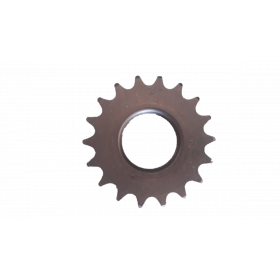 New productFixed screwed sprocket 18 teeth
New productFixed screwed sprocket 18 teeth- €5.99
-
 New productFix sprocket 17 teeth Extra
New productFix sprocket 17 teeth Extra- €14.99
-
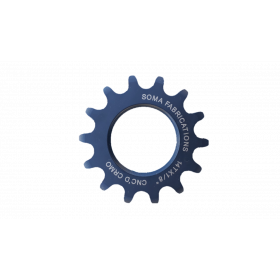 New productSingle speed, fixie, track sprocket Soma 14 teeth BC 1.37"x24T
New productSingle speed, fixie, track sprocket Soma 14 teeth BC 1.37"x24T- €19.99
-
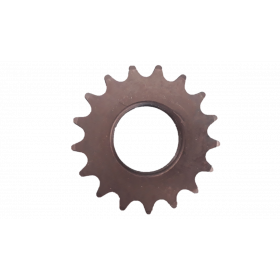 New productFixed screwed sprocket 17 teeth
New productFixed screwed sprocket 17 teeth- €5.99
-
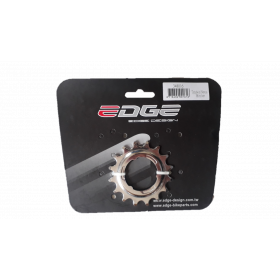 New productSprocket Edge Shimano Nexus 16 teeth
New productSprocket Edge Shimano Nexus 16 teeth- €4.49
-
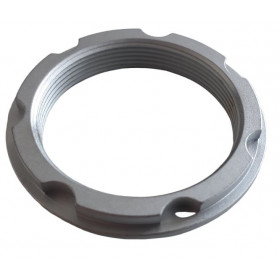 New product -15%Miche track sprocket support
New product -15%Miche track sprocket support- €5.91
- €6.95
-
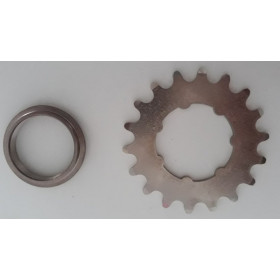 New productMiche fixe sprocket 18 teeth ISO
New productMiche fixe sprocket 18 teeth ISO- €14.99
-
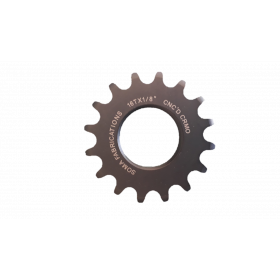 New productSingle speed, fixie, track sprocket Soma 16 teeth BC 1.37"x24T
New productSingle speed, fixie, track sprocket Soma 16 teeth BC 1.37"x24T- €19.99
-
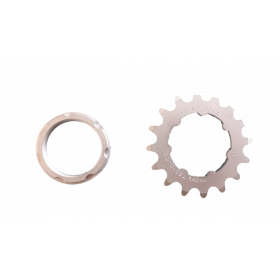 New productSingle speed, fixie, track sprocket Miche 16 teeth ISO
New productSingle speed, fixie, track sprocket Miche 16 teeth ISO- €14.99
-
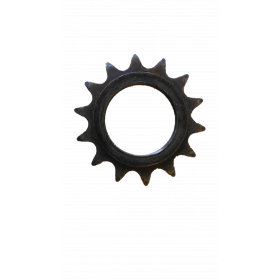 UsedSprocket 14 teeth screwed
UsedSprocket 14 teeth screwed- €8.90
Showing 1-14 of 14 item(s)
Sprockets, also called fixed gears or cogs, are essential components of the drivetrain of fixed gear track bikes. Here is a description of their function, their characteristics, the standards and the different types of sprockets for track bikes:
Function :
1. Power transfer:
The sprockets are mounted on the rear wheel hub and directly receive the pedaling force of the rider, thereby transferring power to the wheels to move the bicycle forward.
2. Determination of transmission ratio:
Sprockets are available in different tooth sizes, allowing the rider to choose the right gear ratio for their strength and riding preferences.
Features :
1. Number of teeth:
Sprockets come in a range of tooth sizes, typically 13 to 18 teeth, although more extreme sizes may be available. A sprocket with fewer teeth will provide a higher speed but require more effort to pedal, while a sprocket with more teeth will provide a lower speed but require less effort.
2. Thread:
Sprockets can be threaded or unthreaded. Threaded sprockets are screwed onto the standard thread of the rear wheel hub, while unthreaded sprockets require the use of a lock nut to secure them in place.
Standards:
1. Thread pitch:
Threaded sprockets are generally available in a standard thread pitch of 1.37" x 24 TPI (threads per inch), although other thread pitches may be used in some applications.
2. Hub Compatibility:
The sprockets must be compatible with the rear wheel hub. Some hubs have specific threads for threaded sprockets, while others require the use of a different fastening system, such as a keyway locking system.
Different types of sprockets for track bikes:
1. Fixed gears:
These sprockets are attached directly to the rear wheel hub and rotate with the wheel. They are used in fixed gear configurations, where the rider can stop the rotation of the pedals by braking or resisting the pedaling motion.
2. Freewheels:
Although less common on track bikes, some riders may choose to use freewheels, which allow the rider to coast without causing the pedals to rotate. These sprockets are generally used with a traditional braking system.
In summary, track bike sprockets are essential parts of the drivetrain, allowing the rider to transfer their pedaling power to the wheels. With specific features such as tooth count, thread and mounting type, as well as manufacturing standards, they contribute significantly to the rider's performance and riding experience on the track.
